Alfredo Di Stéfano
Alfredo Stéfano Di Stéfano Laulhé (born 4 July 1926 in Buenos Aires; † 7 July 2014 in Madrid) was an Argentine football player and coach who also obtained Spanish citizenship in 1956. Since 2000 he was honorary president of his long-time club Real Madrid.
Di Stéfano won the Argentine championship twice with River Plate (1945, 1947). With CD Los Millionarios, as head of the legendary "blue ballet", he won the Colombian championship four times (1949, 1951, 1952, 1953) and the Colombian Cup once (1953). In addition, during his most successful period as head of the legendary "white ballet" with Real Madrid, he won the Spanish championship eight times (1954, 1955, 1957, 1958, 1961, 1962, 1963, 1964), the Spanish Cup once (1962), the European Champion Clubs' Cup five times in a row (1956, 1957, 1958, 1959, 1960), the Coupe Latine twice (1955, 1957) and the World Cup of Club Football once (1960).
With the Argentine national team Di Stéfano won the South American Championship (1947). He also played with the Spanish national team and surprisingly missed the qualification for the 1958 World Cup with them in 1957.
As a coach, in his numerous coaching stints (Spain, Portugal, Argentina), he won the Argentine championship twice (1969, 1981), once with Boca Juniors and once with their arch-rivals River Plate. He also won the Spanish championship (1971) and the European Cup Winners' Cup (1980) with Valencia FC. He also won promotion back to the Primera División with Valencia (1987). With Real Madrid he won the Supercopa de España (1990).
The striker was top scorer in Argentina (1947), Colombia (1951, 1952) and Spain (1954, 1956 to 1959), as well as in the European Champions Cup (1958, 1962).
Di Stéfano was twice awarded the Ballón d'Or as Europe's Footballer of the Year (1957, 1959). He was the only player in history to be awarded the Súper Ballón d'Or (1989) as Europe's footballer of the last three decades. He is also part of Pelé's FIFA 100 and came fourth in FIFA's Player of the Century vote. In 2007 he received the UEFA President's Award and in 2008 he was named UEFA Honorary President. Since 2000, he has been Honorary President of Real Madrid. In his honour, the Real Madrid Castilla stadium (since 2006) is named Estadio Alfredo di Stéfano and the Alfredo di Stéfano Trophy (Marca) is awarded to the best player in the Primera División.
Di Stéfano died of a heart attack in a Madrid hospital at the age of 88. At the 2014 World Cup, a minute's silence was observed in his memory before the kick-off of the semi-final between Argentina and the Netherlands, and Argentina played in mourning flags.
Club career
Origin and beginnings
Alfredo Di Stéfano was born in Buenos Aires on 4 July 1926, the eldest son of Alfredo Di Stéfano Senior and his wife Eulalia (née Laulhé Gilmont), of French descent. His paternal grandfather was of Italian descent (Michele Di Stefano, in Italian without accent) and immigrated to Argentina from the island of Capri. The family lived in the Barracas neighborhood, where the father ran a cattle ranch. In the streets and backyards of this neighborhood on the southeastern outskirts of the metropolis, the young Alfredo's passion for soccer began and from an early age he chased a ball with his siblings or the children of the neighborhood. His father instilled in him a love of River Plate, the club he once played for (from 1910 to 1912), and nurtured his talent. After initially playing for district teams such as Unidos y Venceremos and Imán, Alfredo had a trial with River Plate in 1941. The youth coaches were completely convinced of his abilities and gave the talented youngster a place in the Millonarios' youth team. There, Di Stéfano received further footballing training and was promoted to the reserve team in 1944. His performances soon made him a candidate for the professional squad.
River Plate (1945 to 1949)
River Plate were by far the best club team in South America in the 1940s. Their success was guaranteed by the wonder-storm of Adolfo Pedernera, Félix Loustau, Juan Carlos Muñoz, Ángel Labruna and José Manuel Moreno, known as La Máquina ('The Machine'), who were able to pose almost insurmountable problems to their opponents. In 1945, 18-year-old Di Stefano was promoted to the squad and made his debut on 15 July in a 2-1 win over Club Atletico Huracan. However, with the experienced Adolfo Pedernera in the centre-forward position, Di Stéfano was given few opportunities and agreed to be loaned out to Huracán to gain match practice. In his first full professional season (1945/46) he played 25 league games for the suburban side, scoring a remarkable ten goals. After this successful stint, Di Stéfano returned to River Plate with confidence. Initially a regular at right-back, he was soon recognised by coach José María Minella as a goal-scorer and moved to the centre of attack. His rugged build, breathtaking speed and incredible pace saw him assert himself in the centre-forward position, replacing veteran Pedernera, who moved to Club Atlético Atlanta. Di Stéfano became top scorer with 27 goals in 30 games, making a significant contribution to winning the Argentine championship. The blond striker was a favourite with the press and fans, who nicknamed him La Saeta Rubia ('The Blond Arrow') because of the colour of his hair and his speed.
CD Los Millonarios (1949 to 1953)
In 1948/49, persistent disputes between the league association and the players' union FAA severely hampered regular play in Argentina's Primera División. The union called protracted player strikes to enforce minimum salaries for professionals. As a consequence of these disputes, numerous Argentine stars sought their fortunes abroad, many of them moving to Colombia to play in the Dimayor professional league, founded in 1948. The Dimayor was a de facto split from the official federation and did not take into account the usual procedures of the time, such as the timely release of clubs and transfer payments, which led to the country's temporary exclusion from world governing body FIFA. On the advice of Pederne, who held a leading position in the players' union, Di Stefano moved to Colombia with team-mate Néstor Rossi. Unbeknownst to River Plate, who received no transfer compensation, they both signed for the financially strong capital club CD Los Millonarios in August 1949. The club's president and patron was the wealthy entrepreneur Alfonso Senior Quevedo, a co-founder of Dimayor. At the end of the season, the Millonarios were level on points with Deportivo Cali at the top of the table, but prevailed in the necessary deciders (1-0, 3-1) to eventually win the first league title in their club's history. The team, known as Balet Azul ("Blue Ballet") for their outstanding short passing, dominated the Dimayor. Three more championships followed between 1951 and 1953, and a cup win in 1953. Di Stéfano was the undisputed star, with his goals (top scorer in 1951 and 1952) and outstanding performances playing a major part in the successes. The Millonarios also attracted attention in friendly matches in Europe. In the 1952 Real Madrid 50th anniversary tournament, in particular, Di Stéfano impressed both the professional world and the board of the 'royals', who were beaten 4-2 by the South Americans.
Real Madrid (1953 to 1964)
Turbulent change
Real Madrid's management were delighted with Di Stefano's performances and the desire to sign this exceptional player became a real obsession. But FC Barcelona, another top Spanish club, had expressed an interest and were keen to sign the 25-year-old Argentine. The Catalans paid River Plate four million pesetas (around €217,000). Di Stefano was under contract with CD Los Millonarios in Bogota at the time, but as the Colombians had not transferred any transfer fee to River Plate at the time of his signing, FIFA had ruled that Di Stefano's transfer rights would revert to River Plate at the end of his contract in Colombia. Di Stefano therefore travelled to Barcelona in Spain. However, Real Madrid now became active in the transfer market and one of the strangest transfer deals in football history took its course. After Real and Barça had already had a transfer dispute in 1950 over the signing of László Kubala, at the end of which the Hungarian moved to Barcelona, Real president Santiago Bernabéu was determined not to be outmanoeuvred again. Bernabéu therefore turned to CD Los Millonarios, who still held the transfer rights to Di Stéfano until 31 December 1954, and paid 1.5 million pesetas (around 81,000 euros), but also agreed to compensate River Plate. This created a unique situation where two clubs had paid transfer fees and the Spanish FA had to make a decision on which of the two the player should move to. In agreement with the Spanish Ministry of Sport, the federation decided on 15 September 1953 that Di Stéfano should play two seasons for Real Madrid (1953/54 and 1955/56) and two seasons for FC Barcelona (1954/55 and 1956/57). But Barcelona did not agree with this decision and refrained from signing him, even though Di Stéfano had already played for them in friendlies. He had looked listless and out of form, so they decided not to go through with the transfer, but insisted on Madrid paying him compensation. Bernabéu compensated the Catalans to the tune of four million pesetas, bringing the total value of the Di Stefano deal to a record 5.5 million pesetas (around 298,000 euros). These events further exacerbated the traditional rivalry between the two clubs, and Barcelona's officials subsequently claimed that they had only refrained from signing Di Stéfano under pressure from the Franco government.
Founder of the most successful era in the club's history
On 23 September 1953 he was officially presented by Bernabéu as a newcomer and made his debut in a friendly against AS Nancy (2-4). Di Stéfano's signing proved to be a real stroke of luck for the club, as it ushered in the most successful era in the club's history and created the 'Real Madrid legend'. In his debut season, 1953/54, Di Stéfano became the club's top scorer with 27 goals (Pichichi) and led the team to their long-awaited third championship after a 21-year wait. Di Stefano's performance in the match against FC Barcelona was exceptional, as he single-handedly humiliated their great rivals with four goals in a 5-0 win. The exceptional footballer had long since earned himself the nickname 'The Lance Tip' for his goalscoring prowess and presence in the opposition penalty area. Di Stefano's surprising forays posed problems for almost every defence. With his innate leadership, professionalism and introduction of the short passing game, he transformed Real Madrid into the world's best club side at the time. The team of the fifties and early sixties, which would soon dominate not only the domestic league but also Europe, went down in football history as the "white ballet". Their play was convincing all along the line and their elegant, technically demanding football was reminiscent of a ballet performance with Di Stéfano as conductor. Other exceptional players such as Héctor Rial, Francisco Gento, Raymond Kopa, Ferenc Puskás and José Santamaría found their way to the 'royals', who were soon described as unconquerable. Despite this collection of top-class individual talents, Di Stéfano was always the undisputed head of the team and the other players subordinated themselves unconditionally to his leadership. He won eight Primera División championships (1954, 1955, 1957, 1958, 1961 to 1964) and one cup (1962) with Real Madrid. In addition to the successes at national level, the newly created European Cup of Champions brought the great glory. Real secured the coveted trophy in the first five editions of the competition, a milestone in football that remains unmatched today: a 4-3 win over Stade Reims in 1956, a 2-0 win over AC Florence in 1957, a 3-2 n. v. win over AC Milan in 1958, a 2-0 win over Stade Reims in 1959 and a 7-3 win over Eintracht Frankfurt in 1960. Di Stéfano had managed the feat of scoring a goal in every final, and against Frankfurt he even scored three times. Winning the 1960 World Cup completed the collection of titles. The Franco regime, isolated in foreign policy terms, knew how to exploit these international successes and the propaganda stylised Real Madrid as an international showpiece.
How to play
Di Stefano's style of play was characterised by a particular elegance, and on the pitch he had the natural aura of a grand seigneur. He was not just an enforcer waiting for his chance in the centre of attack, but a complete player whose reach extended from his own area to the opposition penalty area. The General" often dropped back into midfield to organise the build-up play of his team as a playmaker. Particularly noteworthy was his interplay with his congenial partner Ferenc Puskás, whose arrival in 1958 united La Máquina's style of play with that of Hungary's golden eleven. The 7-3 victory over Eintracht Frankfurt in the 1960 European Champion Clubs' Cup final was the culmination of the 'white ballet' and the interplay between Di Stéfano, who scored three goals, and Puskás, who contributed the remaining four. For all his individual prowess, Di Stéfano was always at the service of his team and, as a charismatic leader, never sought to set himself apart from his team-mates. He always attributed his triumphs to a functioning team game: "Football has given me everything. I always understood it as a team game and made it clear that I didn't want to be idolised, I wanted to play. And to do that you have to run and sweat." The sports newspaper France Football paid tribute to his skills by awarding Di Stéfano the Ballon D'Or as Europe's Footballer of the Year twice (1957 and 1959).
End of club career with Real Madrid
In 1961, Real Madrid's nimbus of invincibility on the European stage was broken. They were eliminated by FC Barcelona in the first round of the European Champion Clubs' Cup and lost 5-3 to Benfica Lisbon in the final the following year. Likewise, the Sixties' championships lacked the glamour of previous years, and Di Stéfano was also taking his toll on age. After losing the 1964 European Cup final to Inter Milan 3-1, club president Bernabéu tried to persuade Di Stéfano, now 38, to retire and take up the post of sporting director. Di Stéfano, who had already exerted considerable influence on the club's transfer policy in previous years, wanted to continue his career and declined. No agreement was reached and the future honorary president left Madrid in disarray to join Espanyol Barcelona. The defeat to Inter Milan on 27 May 1964 was thus Di Stéfano's last competitive game for the 'royals'. During his eleven years in the spotless white Real shirt, he played 396 competitive games and scored 307 goals (Primera División: 282/216; Copa del Rey: 50/39; European Cup: 58/49; Others: 6/3). That made Di Stéfano the club's record goalscorer for over four decades, before that mark was surpassed by Raúl. He was also the first player ever to become the Primera División's top scorer four times in a row, a feat second only to Hugo Sánchez (1985-1988).
Hijack
During his time at Real, Di Stéfano was the victim of a kidnapping by the FALN during a trip to Venezuela in 1963. Early in the morning there was a knock at his hotel room in Caracas, three uniformed men stood in front of his door. They identified themselves as police officers and asked the Argentine to accompany them to the police station. The footballer was said to be suspected of possessing drugs - which turned out to be just a pretext. Suspecting he was merely the victim of a big misunderstanding, di Stéfano accompanied the group. Later, in the car, the supposed policemen revealed that they were from the FALN group, a radical left-wing guerrilla organization. The kidnappers made it clear to him that they would take him hostage, but that nothing would happen to him if he played by the rules. The separatist movement, consisting of regime critics, revolutionaries and radicalized members of the communist party, had set itself the goal of protesting against the government of the Venezuelan president at the time, Rónulo Betancourt - and the idea worked. The kidnapping of the most successful footballer of the time gave the FALN a strong media and public presence. The kidnapping graced the covers of magazines around the world. The success of the operation was fortunate for Di Stéfano. Because the sole objective - to draw attention to conditions in Venezuela - was achieved with the kidnapping, the Argentine was released after 72 hours in custody. The kidnappers took the player to the Avenida Libertadores and told him to get out. There he took a taxi and drove to the Spanish embassy. Despite the ordeal, the victim demonstrated understanding of the movement's goals and concerns: These were altruists, they have ideals, the footballer afterwards gave himself empathetically. In the end he got away with the horror and remained unharmed. At the request of the Bernabéu board, he even returned to his vocation on the day of his release, playing half-time against Sao Paulo before having to be substituted due to exhaustion. Afterwards, reports circulated that he had played cards and chess with his captors during his captivity, as if the Argentine had made new friends. Whether he remained in contact with his tormentors is not reported.
RCD Espanyol Barcelona (1964 to 1966)
In 1964 Di Stéfano joined Espanyol Barcelona, winding down his active career after two seasons (1964/65: 11th and 1965/66: 12th). It was here that he briefly teamed up with László Kubala, another legend of Spanish football.
On 7 June 1967, Alfredo Di Stéfano retired from football and ended his career. A farewell match was played in his honour at the Estadio Santiago Bernabéu in front of 130,000 spectators against CelticGlasgow, the reigning winners of the European Champion Clubs' Cup.
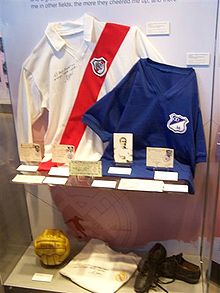
Memorabilia of Di Stéfano in the museum of Real Madrid
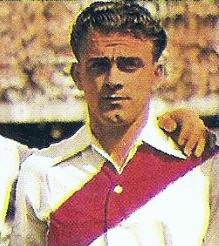
Di Stéfano as a River Plate player
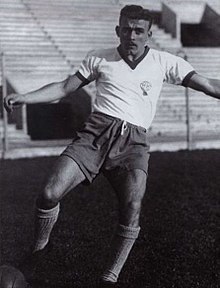
In the jersey of CA Huracán (1946)
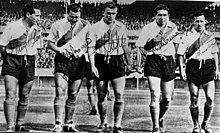
Di Stéfano as part of La maquina (River Plate's Miracle Storm), 1947.
National Team Career
Argentina
In 1947, Argentina coach Guillermo Stábile named 21-year-old Di Stéfano in the squad for the upcoming South American Championship (Copa América). He made his debut there on 4 December in the match against Bolivia (7-0) and scored one goal. The Argentine national football team were the outstanding team of the tournament, winning the title in commanding fashion, while Di Stéfano scored six times in six appearances. Although his career with the national team had begun auspiciously, no further international appearances were made as the players who played in Colombia were not nominated.
Colombia
In 1949 he played four unofficial international matches for Colombia, which were not recognised by FIFA.
Spain
After becoming a Spanish citizen in 1956, Di Stéfano, a naturalised Argentine, was eligible to play for the Spanish national team. He made his first appearance for the Selección on 30 January 1957, scoring twice in a 5-0 win over the Netherlands. Despite the presence of outstanding players such as Di Stéfano, Francisco Gento, Luis Suárez and László Kubala, Spain surprisingly failed to qualify for the 1958 World Cup, although they did four years later for the tournament in Chile, where Di Stéfano was joined by fellow naturalised Hungarian Ferenc Puskás. However, a persistent muscle injury prevented the now 36-year-old veteran from playing, which is why the friendly against France on 10 December 1961 was Di Stéfano's last international match. He joins the ranks of world-class players such as Ryan Giggs (Wales), George Best (Northern Ireland) and George Weah (Liberia) who have never played in a World Cup.
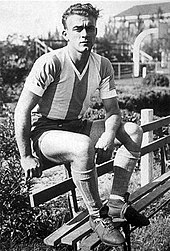
Di Stéfano during the South American Championship 1947
Search within the encyclopedia